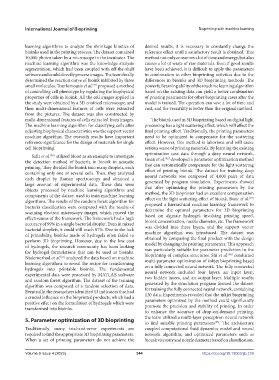Page 352 - IJB-9-4
P. 352
International Journal of Bioprinting Bioprinting with machine learning
learning algorithms to analyze the shrinkage kinetics of desired results, it is necessary to constantly change the
bioinks used in the printing process. The dataset contained reference effect until a satisfactory result is obtained. This
10,000 photos taken by a microscope in the incubator. The method not only consumes a lot of time and energy, but also
machine learning algorithm was the knowledge analysis causes a lot of waste of raw materials. Even if good results
segmentation, which had been coupled with off-the-shelf have been achieved, it is difficult to apply the parameters
software and could directly process images. The team finally in combination to other bioprinting activities due to the
determined the reaction curve of bioink inhibited by three differences in bioinks and 3D bioprinting methods. The
small molecules. Tourlomousis et al. proposed a method powerful learning ability of the machine learning algorithm
[79]
of controlling cell phenotype by regulating the biophysical based on the existing data can yield a better combination
properties of cells in bioink. All the cell images applied in of printing parameters for other bioprinting cases after the
the study were obtained by a 3D confocal microscope, and model is trained. The operation can save a lot of time and
then multi-dimensional features of cells were extracted cost, and the versatility is better than the original method.
from the pictures. The dataset was also constructed by
multi-dimensional features of cells extracted from images. The bioink used in 3D bioprinting based on digital light
The machine learning algorithm for classifying cells after processing has a light scattering effect, which will affect the
adjusting biophysical characteristics was the support vector final printing effect. Traditionally, the printing parameters
machine algorithm. The research results have important need to be optimized to compensate for the scattering
reference significance for the design of materials for single effect. However, this method is laborious and will cause
cell bioprinting. serious waste of printing materials. By learning the existing
Safir et al. utilized blood as an example to investigate optimization case data through a deep neural network,
[80]
[82]
the detection method of bacteria in bioink in acoustic Guan et al. developed a parameter optimization method
printing. They divided the bioink into many droplets, each that can automatically compensate for the light scattering
containing only one or several cells. Then, they analyzed effect of printing bioink. The dataset for training deep
each droplet by Raman spectroscopy and obtained a neural networks was composed of 4,000 pairs of data
large amount of experimental data. These data were generated by program simulation. Experiments showed
objects processed by machine learning algorithms and that after optimizing the printing parameters by the
components of the dataset used to train machine learning method, the 3D bioprinter had an excellent compensation
[83]
algorithms. The results of the random forest algorithm for effect on the light scattering effect of bioink. Bone et al.
bacteria classification were compared with the results of proposed a hierarchical machine learning framework to
scanning electron microscopy images, which proved the determine the optimal parameters for 3D bioprinting
effectiveness of the framework. The framework had a high based on alginate hydrogel, involving printing speed,
accuracy of 99% in a single bacterial droplet. Even in mixed bioink concentration, nozzle diameter, etc. The framework
bacterial droplets, it could still reach 87%. Due to the lack was divided into three layers, and the support vector
of printability, bioinks made of hydrogels often failed to machine algorithm was introduced. The dataset was
perform 3D bioprinting. However, due to the low cost obtained by comparing the final product with the design
of hydrogels, the research community has been looking model by changing the printing parameters. This approach
for hydrogel formulations that can be used as bioinks. was particularly suitable for parameter prediction in the
[84]
Nadernezhad et al. analyzed the data based on machine bioprinting of complex structures. Shi et al. conducted
[81]
learning algorithms to reveal the recipe for transforming multi-parameter optimization of inkjet bioprinting based
hydrogels into printable bioinks. The fundamental on a fully connected neural network. The fully connected
experimental data were processed by MATLAB software neural network included four layers: an input layer,
and random forest algorithm. The dataset of the training two hidden layers, and an output layer. Multiple results
algorithm was composed of a random selection of data. generated by the simulation program formed the dataset
Eventually, the researchers identified 13 indicators that had for training the fully connected neural network, containing
a crucial influence on the bioprinted products, which had a 120 data. Experiments revealed that the inkjet bioprinting
positive effect on the formulation of hydrogels which were parameters optimized by the method could significantly
transformed into bioinks. promote the precision and stability of printing. In order
to enhance the accuracy of drop-on-demand printing,
5. Parameter optimization of 3D bioprinting the team utilized a multi-layer perceptron neural network
to find suitable printing parameters . The architecture
[85]
Traditionally, many trial-and-error experiments are coupled computational fluid dynamics model and neural
required to find the appropriate 3D bioprinting parameters. network algorithm, and optimized parameters such as
When a set of printing parameters do not achieve the bioink viscosity and nozzle diameter based on classification.
Volume 9 Issue 4 (2023) 344 https://doi.org/10.18063/ijb.739

